财务管理英文版(PPT 60页)
合集下载
企业财务管理基础知识英文版
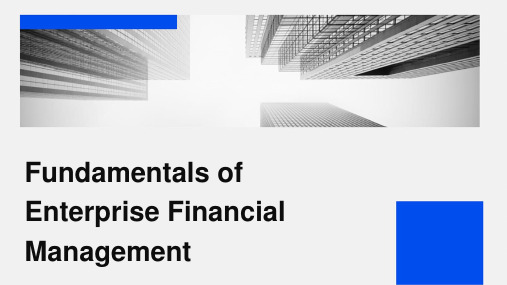
The income statement includes items such as operating income, operating costs, taxes and surcharges, period expenses, operating profit, and total profit. Through these data, the profitability and operating efficiency of the enterprise can be understood.
Fundamentals of Enterprise Financial Management
CATALOGUE
目录
Overview of Enterprise Financial ManagementFinancial statements and analysisCapital budgeting and investment decision makingFundraising and Capital Structure ManagementWorking capital management
Financial ratio analysis: By calculating various financial ratios, such as current ratio, quick ratio, inventory turnover ratio, accounts receivable turnover ratio, etc., evaluate a company's debt paying ability, operating ability, and profitability.
财务管理分析与案例(英文版)(9个ppt)5

6-6
TABLE 6-3 Debt Ratios, 1992 - 1997 (numbers in parentheses are the number of companies in the Industry sample)
Standard & Poor's 400 Industrials: Debt to total assets* (%) Times interest earned
27%
-19%
-40%200%
76%
28%
-20%
2100%%
78%
29% 100-%21%
200%
220%
81%
30%
-22%
230%
83%
30%
-22%
Financial leverage (debt/equity)
240%
86%
31%
-23%
Boom ROIC = 28%
Expected ROIC = 12%
IБайду номын сангаасterest expense
Principal payment
Common dividends
Stock
Aftertax Before Tax $16
Bonds
Aftertax Before Tax $52
$40
67
$55
92
33
55
25
42
Irwin/McGraw-Hill
Copyright © 2001 by The McGraw-Hill Companies, Inc. All rights reserved.
1992
20 3.0
财务管理英文课件Cha

Profit budget
Identify the objectives and goals of the business: It is essential to understand the objectives and goals of the business before preparing a budget This helps to align the budget with the overall strategy of the organization
It provides direction: A financial plan serves as a roadmap, guiding businesses towards their financial goals It identifies the financial objectives and milestones to be achieved, allowing businesses to plot a course towards their desired outcomes
Financial Management PPT Englndamentals of Financial ManagementFinancial statement analysisBudget and financial planInvestment decisionFinancial risk management
It shows the company's assets, liabilities, and equity, and is used to assess the company's financial health and solvency The balance sheet is prepared at the end of each accounting period and is an important tool for investors and credits to evaluate a company's financial strength and creditworthiness
Identify the objectives and goals of the business: It is essential to understand the objectives and goals of the business before preparing a budget This helps to align the budget with the overall strategy of the organization
It provides direction: A financial plan serves as a roadmap, guiding businesses towards their financial goals It identifies the financial objectives and milestones to be achieved, allowing businesses to plot a course towards their desired outcomes
Financial Management PPT Englndamentals of Financial ManagementFinancial statement analysisBudget and financial planInvestment decisionFinancial risk management
It shows the company's assets, liabilities, and equity, and is used to assess the company's financial health and solvency The balance sheet is prepared at the end of each accounting period and is an important tool for investors and credits to evaluate a company's financial strength and creditworthiness
财务管理(英文第十三版)Ch 4_sheena

Cash Flow: only the face value received
at maturity.
Fundamentals of Financial
22
Management /12th Edition
Zero-Coupon Bond
and face value at maturity
V=
I
(1 + kd)1
I
I + MV
+ (1 + kd)2 + ... + (1 + kd)n
nI
=S t=1
(1 + kd)t
+
MV
(1 + kd)n
V = I (PVIFA kd, n) + MV (PVIF kd, n)
Fundamentals of Financial
Types of Bonds
A non-zero coupon-paying bond is a bond has a finite maturity and the bondholder receive interest payment and face value at maturity
Cash Flow: not only the fixed annual interest payment, but also the face value at maturity.
V = $120 (PVIFA10%, 30) + $1,000 (PVIF10%, 30) = $120 (9.427) + $1,000 (.057)
[Table IV]
[Table II]
= $1131.24 + $57
财务管理英文课件Operating-and-Financial-Leverage.ppt
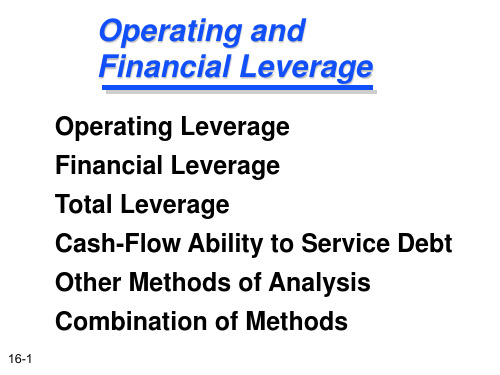
16-4
Impact of Operating Leverage on Profits
(in thousands) Firm F Firm V Firm 2F
Sales
$15
Operating Costs
$16.5 $29.25
Fixed
7
Variable
3
Operating Profit $ 5
Break-Even (Quantity) Point
Break-Even Point -- The sales volume required so that total revenues and total costs are equal; may be in units or in sales dollars.
volume.
When studying operating leverage, profits refers to operating profits before taxes (i.e., EBIT) and excludes
debt interest and dividend payments.
16-1
Operating Leverage
Operating Leverage -- The use of fixed operating costs by the firm.
One potential effect caused by the presence of operating leverage is that a change in the volume of sales results in a more than proportional change in operating profit (or loss).
Impact of Operating Leverage on Profits
(in thousands) Firm F Firm V Firm 2F
Sales
$15
Operating Costs
$16.5 $29.25
Fixed
7
Variable
3
Operating Profit $ 5
Break-Even (Quantity) Point
Break-Even Point -- The sales volume required so that total revenues and total costs are equal; may be in units or in sales dollars.
volume.
When studying operating leverage, profits refers to operating profits before taxes (i.e., EBIT) and excludes
debt interest and dividend payments.
16-1
Operating Leverage
Operating Leverage -- The use of fixed operating costs by the firm.
One potential effect caused by the presence of operating leverage is that a change in the volume of sales results in a more than proportional change in operating profit (or loss).
FinancialManagement(财务管理,英文版)
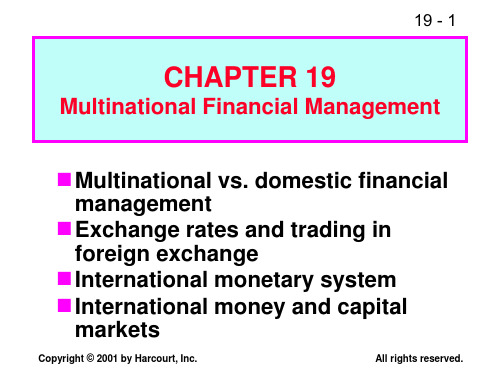
Japanese yen
111.11
Australian dollar
1.5385
Yen:
1/0.009 = 111.11.
A. Dollar: 1/0.650 = 1.5385.
Copyright © 2001 by Harcourt, Inc.
All rights reserved.
What is a cross rate?
domestic financial management?
1. Different currency denominations.
2. Economic and legal ramifications.
3. Language differences.
4. Cultural differences.
1 Unit
Japanese yen
0.009
Australian dollar
0.650
Are these currency prices direct or indirect quotations?
Since they are prices of foreign currencies expressed in dollars, they are direct quotations.
the dollar profit on the sale?
250 yen = 250(0.0138) = 3.45 A. dollars. 6 – 3.45 = 2.55 Australian dollar profit. 1.5385 A. dollars = 1 U. S. dollar. Dollar profit = 2.55/1.5385 = $1.66.
财务管理英文课件

利润分配原则: 公平、公正、公 开
利润分配方式: 现金分红、股票 分红、实物分红 等
利润分配比例: 根据公司经营状 况、股东权益等 因素确定
利润分配时间: 根据公司财务状 况和股东需求确 定
财务预算
预算编制:根据公司战略和经营计划,制定财务预算 预算内容:包括收入、成本、费用、利润等各项财务指标 预算执行:按照预算执行,确保各项财务指标的实现 预算调整:根据实际情况,对预算进行调整,确保预算的准确性和可行性
社会环境:社会文化、价值观等 对企业财务管理的影响
添加标题
添加标题
添加标题
添加标题
法律环境:企业财务管理的法律 框架和规定
技术环境:新技术对企业财务管 理的影响,如云计算、大数据等
财务决策制定
投资决策
投资目标:确定 投资目标,如收 益最大化、风险 最小化等
投资策略:选择 合适的投资策略, 如分散投资、长 期投资等
财务分析
财务比率分析
流动比率:衡量企业短期偿债能力
权益乘数:衡量企业财务杠杆水平
速动比率:衡量企业立即偿债能力 资产负债率:衡量企业长期偿债能力
利息保障倍数:衡量企业偿付利息能 力
现金流量比率:衡量企业现金流量状 况
财务趋势分析
趋势分析的定义和目的 趋势分析的方法和工具 趋势分析的步骤和流程 趋势分析的应用和案例
财务管理基础知识
财务管理的概念
财务管理是组织 对资金、资产、 负债、收入、支 出等财务活动的 管理
财务管理的目标 是实现企业价值 最大化
财务管理的内容 包括财务计划、 财务控制、财务 决策、财务分析 等
财务管理的原则 包括成本效益原 则、风险控制原 则、信息透明原 则等
财务管理ppt英文课件Chapter 15

Cost of Equity Approaches
Dividend Discount Model Capital-Asset Pricing Model Before-Tax Cost of Debt plus Risk
Premium
Copyright 2001 Prentice-Hall, Inc.
11
Fundamentals of Financial Management, 11/e by Van Horne and Wachowicz.
Slides prepared by Wu Xiaolan
Dividend Discount Model
The cost of equity capital, ke, is the discount rate that equates the present value of all expected future dividends with the current market price of the stock.
Chapter 15
Required Returns and the Cost of Capital
Chapter Objectives
Estimate values for the costs of debt and preference shares.
Calculate the WACC.
P0 =
D1 (1+ke)1
+
D2 (1+ke)2
+
.
.
.
+
D (1+ke)
Copyright 2001 Prentice-Hall, Inc.
财务管理英文Cha3课件
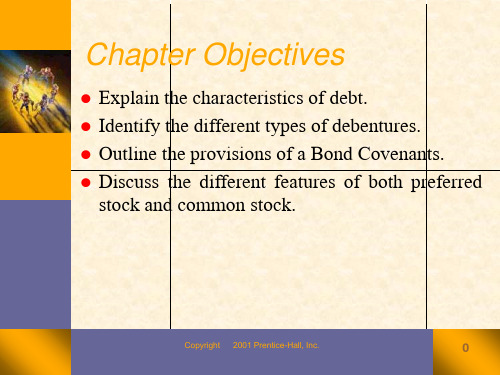
➢ Assets covenants ➢ Dividend covenants ➢ Financing covenants ➢ Bonding covenants ➢ Financial ratio covenants ➢ Sinking fund covenants.
Not all of these types of covenants are included in every bond.
Copyright 2001 Prentice-Hall, Inc.
9
Bonding covenants
Describe the mechanism for enforcement of the covenants.
For example, the mechanism includes an independent audit of the company’s financial statements and appointment of a trustee to represent the bondholders and monitor the firm’s compliance with bond covenants.
Chapter Objectives
Explain the characteristics of debt. Identify the different types of debentures. Outline the provisions of a Bond Covenants. Discuss the different features of both preferred
Copyright 2001 Prentice-Hall, Inc.
13
Not all of these types of covenants are included in every bond.
Copyright 2001 Prentice-Hall, Inc.
9
Bonding covenants
Describe the mechanism for enforcement of the covenants.
For example, the mechanism includes an independent audit of the company’s financial statements and appointment of a trustee to represent the bondholders and monitor the firm’s compliance with bond covenants.
Chapter Objectives
Explain the characteristics of debt. Identify the different types of debentures. Outline the provisions of a Bond Covenants. Discuss the different features of both preferred
Copyright 2001 Prentice-Hall, Inc.
13
财务管理 英文版PPT课件

1
Chapter
The Goals and Functions of Financial Management
Copyright © 2008 by The McGraw-Hill CompanieMs, IcnGc.rAalwl r-iHghitlsl/rIerswerivned.
Chapter Outline
– Cash and inventory management – Capital structure theory – Dividend policy
1-5
Modern Issues in Finance
• Focus has been on:
– Risk-return relationships – Maximization of return for a given level of risk – Portfolio management – Capital structure theory
– Income statements – Balance sheets – Statement of cash flows
• Finance links economic theory with the numbers of accounting
1-3
Evolution of the Field of Finance
• At the turn of the century: Emerged as a field separate from economics
• By 1930s: Financial practices revolved around such topics as:
– Preservation of capital – Maintenance of liquidity – Reorganization of financially troubled
Chapter
The Goals and Functions of Financial Management
Copyright © 2008 by The McGraw-Hill CompanieMs, IcnGc.rAalwl r-iHghitlsl/rIerswerivned.
Chapter Outline
– Cash and inventory management – Capital structure theory – Dividend policy
1-5
Modern Issues in Finance
• Focus has been on:
– Risk-return relationships – Maximization of return for a given level of risk – Portfolio management – Capital structure theory
– Income statements – Balance sheets – Statement of cash flows
• Finance links economic theory with the numbers of accounting
1-3
Evolution of the Field of Finance
• At the turn of the century: Emerged as a field separate from economics
• By 1930s: Financial practices revolved around such topics as:
– Preservation of capital – Maintenance of liquidity – Reorganization of financially troubled
精品课程财务管理基础-英文课件ch16
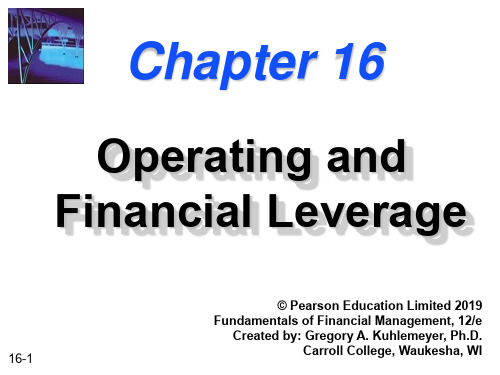
16-9
Break-Even Chart
REVENUES AND COSTS ($ thousands)
250
175
100 Losses
50
Total Revenues Profits
Total Costs
Fixed Costs Variable Costs
16-10
0 1,000 2,000 3,000 4,000 5,000 6,000 7,000 QUANTITY PRODUCED AND SOLD
7
3
$ 2 $ 2.5
FC/total costs .78
FC/sales
.70
.22 .82 .18 .72
16-5
Impact of Operating Leverage on Profits
Now, subject each firm to a 50% increase in sales for next year.
Fixed costs are $100,000 Baskets are sold for $43.75 each Variable costs are $18.75 per basket
16-14
Break-Even Point (s)
Breakeven occurs when:
QBE = FC / (P - V) QBE = $100,000 / ($43.75 - $18.75) QBE = 4,000 Units SBE = (QBE )(V) + FC SBE = (4,000 )($18.75) + $100,000 SBE = $175,000
16-3
Operating Leverage
Break-Even Chart
REVENUES AND COSTS ($ thousands)
250
175
100 Losses
50
Total Revenues Profits
Total Costs
Fixed Costs Variable Costs
16-10
0 1,000 2,000 3,000 4,000 5,000 6,000 7,000 QUANTITY PRODUCED AND SOLD
7
3
$ 2 $ 2.5
FC/total costs .78
FC/sales
.70
.22 .82 .18 .72
16-5
Impact of Operating Leverage on Profits
Now, subject each firm to a 50% increase in sales for next year.
Fixed costs are $100,000 Baskets are sold for $43.75 each Variable costs are $18.75 per basket
16-14
Break-Even Point (s)
Breakeven occurs when:
QBE = FC / (P - V) QBE = $100,000 / ($43.75 - $18.75) QBE = 4,000 Units SBE = (QBE )(V) + FC SBE = (4,000 )($18.75) + $100,000 SBE = $175,000
16-3
Operating Leverage
- 1、下载文档前请自行甄别文档内容的完整性,平台不提供额外的编辑、内容补充、找答案等附加服务。
- 2、"仅部分预览"的文档,不可在线预览部分如存在完整性等问题,可反馈申请退款(可完整预览的文档不适用该条件!)。
- 3、如文档侵犯您的权益,请联系客服反馈,我们会尽快为您处理(人工客服工作时间:9:00-18:30)。
Project Evaluation: Alternative Methods
Payback Period (PBP) Internal Rate of Return (IRR) Net Present Value (NPV) Profitability Index (PI)
Proposed Project Data
Payback Period (PBP)
0
1
2
3
4
5
-40 K
10 K
12 K
15 K
10 K
7K
PBP is the period of time required for the cumulative expected cash flows from an investment project to equal
Julie Miller is evaluating a new project for her firm, Basket Wonders (BW).
She has determined that the after-tax cash flows for the project will be
$10,000; $12,000; $15,000; $10,000; and $7,000, respectively, for each of
ICO =
CF1 (1+IRR)1
+
CF2 (1+IRR)2
+
.
.
.
+
CFn (1+IRR)n
IRR Solution
$40,000 = $10,000
$12,000 +
+
(1+IRR)1 (1+IRR)2
$15,000 + $10,000 + $7,000 (1+IRR)3 (1+IRR)4 (1+IRR)5
negative cumulative cash flow
value.
PBP Acceptance Criterion
The management of Basket Wonders has set a maximum PBP of 3.5 years for projects of this type.
Chapter 13
Capital Budgeting Techniques
Capital Budgeting Techniques
Project Evaluation and Selection Potential Difficulties Capital Rationing Project Monitoring Post-Completion Audit
the initial cash outflow.
Payback Solution (#1)
0
1
2
3 (a)
4
5
-40 K(-b) 10 K 10 K
12 K 22 K
15 K
10 K(d) 7 K
37 K(c) 47 K 54 K
Cumulative Inflows
PBP
=a+(b-c)/d = 3 + (40 - 37) / 10 = 3 + (3) / 10 = 3.3 Years
the Years 1 through 5. The initial cash outlay will be $40,000.
Independent Project
For this project, assume that it is independent of any other potential projects that Basket Wonders may undertake. Independent -- A project whose acceptance (or rejection) does not prevent the acceptance of other projects under consideration.
Cutoff period is subjective
Internal Rate of Return (IRR)
IRR is the discount rate that equates the present value of the future net cash
flows from an investment project with the project’s initial cash outflow.
Should this project be accepted?
Yes! The firm will receive back the initial cash outlay in less than 3.5 years. [3.3 Years < 3.5 Year Max.]
PBP Strengths and Weaknesses
Strengths:
Easy to use and understand
Can be used as a measure of liquidity
Easier to forecast ST than LT flows
Weaknesses:
Does not acct consider cash flows beyond the PBP
Payback Solution (#2)
0
1
2
3
4
5
-40 K -40 K
10 K -30 K
12 K -18 K
15 K -3 K
10 K 7K
7K 14 K
PBP = 3 + ( 3K ) / 10K
Cumulative Cash Flows
= 3.3 Years
Note: Take absolute value of last
Find the interest rate (IRR) that causes the discounted cash flows to equal $40,000.
IRR Solution (Try 10%)
$40,000 = $10,000(PVIF10%,1) + $12,000(PVIF10%,2) + $15,000(PVIF10%,3) + $10,000(PVIF10%,4) + $ 7,000(PVIF10%,5)
